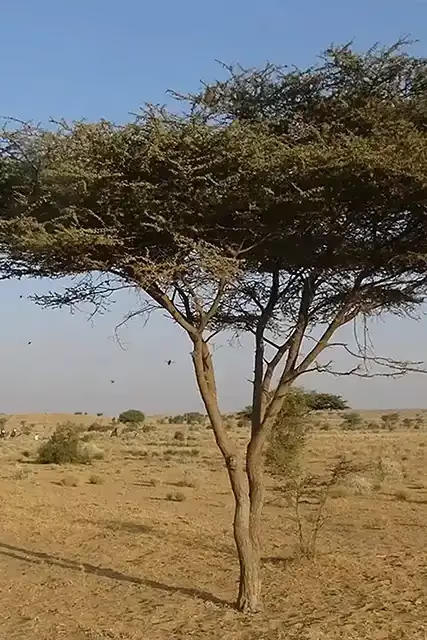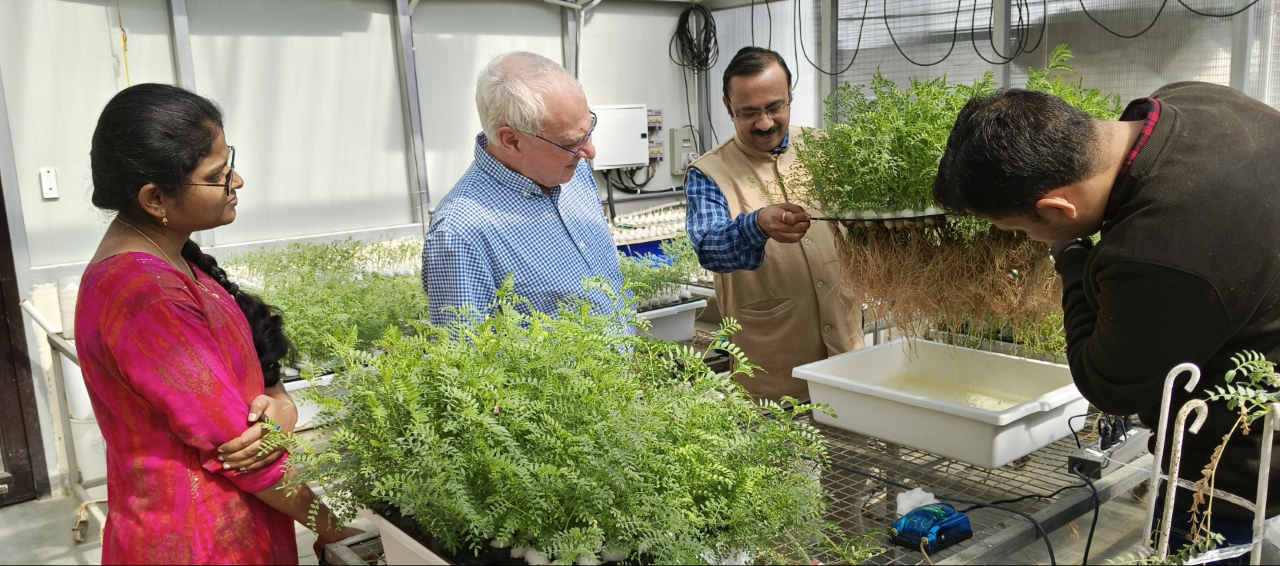Non-native trees introduced for quick greening are causing big problems






When local authorities and real estate developers in Rajkot aimed to expand the city's green cover, Conocarpus seemed an ideal choice. Native to Africa, this tree was affordable, fast-growing—reaching up to 20 feet in just two years—and featured glossy leaves and vibrant flowers. It thrived in hot conditions, required minimal water, and could grow well using drainage and sewage water.
However, in late 2023, the Gujarat government banned the planting of Conocarpus in both forested and non-forested areas. In a circular dated September 26, SK Chaturvedi, principal chief conservator of forests, stressed the importance of controlling this “unfamiliar species”. Research had indicated that Conocarpus could cause respiratory problems due to its pollen, and damage infrastructure like telecommunication lines, drainage systems, and water supplies with its extensive root system.
It is not an isolated incident. In recent years, several states have taken measures to limit the spread of non-native plants. While Telangana has banned Conocarpus as well, states like Delhi, Karnataka, Punjab, Kerala, Rajasthan, Maharashtra, Sikkim and Tamil Nadu have targeted species such as Prosopis juliflora, Acacia tortilis, Acacia mearnsii, Gliricidia sepium, Chinese teak, Lantana camara, and eucalyptus, among others.
Going green
A common link among these species is their introduction through greening programs. For over 200 years, India has experimented with tree plantations, a practice that began in the mid-18th century during British rule. At the time, forest officials extensively planted European and North American pines in the Himalayan region, and introduced Australian acacia species. In Delhi, they planted Prosopis juliflora, while in Kerala, eucalyptus trees were introduced.
“They brought over 40 species to the Nilgiri plateau, including cinchona, eucalyptus, acacias, pines, and Cedrus deodara," says Rajat Nayak from the Foundation for Ecological Research Advocacy and Learning (FERAL).
The introduction and planting of these species continued under various forestry programs, even after the end of British rule. "Non-native species were often used in greening programs, particularly in arid regions," says Chetan Misher, a biologist at the Ashoka Trust for Research in Ecology and the Environment. For instance, in the 1950s, river damming increased soil salinity in Gujarat’s Banni grasslands. To combat this, Prosopis juliflora, a salt-tolerant tree from South America, was introduced in the 1960s.

Even recent government initiatives, such as the National Agroforestry Policy (2014) and the National Mission for a Green India, continued to introduce fast-growing exotic species like eucalyptus and exotic poplars. Other species, like Lantana camara, were introduced for beautification.
While these trees were meant to combat climate change and increase green cover, they instead dominated ecosystems, often to the detriment of native biodiversity. In other words: they became invasive.
Invasive growth
The International Union for Conservation of Nature (IUCN), an international organisation working in the field of nature conservation and sustainable use of natural resources, lists invasive alien species (IAS) as non-native organisms that pose a threat to biodiversity, ecosystem services, or human well-being. A 2022 study published in Biological Invasions reveals that India is home to more than 2,000 alien species. Further, in 2023, when scientists from India and six other countries compiled an inventory of plants introduced in South Asian countries that have become IAS, the country topped the list with 185 such plant species.

Among them is the notorious Lantana camara, which finds a mention among 100 of the World's Worst Invasive Alien Species. It alone has invaded 44% of India’s forests, threatening tiger habitats, competing with native flora, and reducing available foliage for herbivores. Similarly, more than 50% of Gujarat’s Banni grasslands have transformed from grassy plains into dense, woody thickets dominated by Prosopis juliflora. Invasive alien species like eucalyptus, acacia, Lantana camara and Senna spectabilis have also reduced food availability in forests, pushing wildlife into human settlements and farmlands.
It’s resulted in a sharp rise in human-wildlife conflict. In Kerala, for instance, according to the forest department data, there were 7966 wildlife attacks in 2021-22. Most of these conflicts were with farmers living near forested areas. Almost every district in the state has reported such incidents.
Invasive species also contribute to the spread of wildfires, hinder the regeneration of native flora, and deplete resources essential to local communities. They are more adaptable and capable of thriving in diverse environments, making them better suited to cope with the effects of climate change. “While there are no precise estimates of the total area impacted by IAS, they tend to thrive in areas that offer a combination of sunlight and moisture,” says Karuna Jha, a conservationist focused on forest preservation in Jharkhand.
Findings reveal that invasive species increase water loss through transpiration, which reduces stream flows and affects water availability for drinking and power generation, especially during dry periods.
Ultimately, their spread can significantly reduce native biodiversity. For example, the unique montane grasslands of the Nilgiris, home to endemic species like the Nilgiri Tahr and Nilgiri Pipit, face a serious conservation threat due to these invasives. In Kerala, the elephant population has shrunk to 2,386 in 2023, a decline of 58.19% compared to the elephant count of 5,706 in 2017, as per data released by the state forest department. Experts believe that invasive plants have a role to play in this decline.
Researchers have also been studying the effects of invasive species on the hydrological and nutrient cycles in the Upper Nilgiris. “Their findings reveal that invasive species increase water loss through transpiration, which reduces stream flows and affects water availability for drinking and power generation, especially during dry periods. Additionally, they’ve found that areas invaded by woody plants face increased flood risks due to reduced water retention and higher runoff during heavy rains, along with greater phosphate and nitrate outflows,” says Nayak.
Removing root and stem
Yet, despite the widespread presence of invasive plants, their economic impact remains vastly under-researched in India compared to that of invasive animals. But it will be profound. A 2022 study by Bang and colleagues estimated that India had incurred $127 billion in damages over the last six decades due to the cost of managing invasive alien species, averaging $2-3 billion annually.
Which means that preventing the spread of invasive species is the most effective and cost-efficient strategy for management—though easier said than done. India, a signatory to the Bonn Challenge, has committed to restoring 26 million hectares of degraded land by 2030. It needs data validation. “To identify a forest in a 30-by-30-pixel satellite image, sufficient tree cover on the ground is necessary. This requires planting trees more densely than the natural 10-40% canopy cover. Only fast-growing species like teak, eucalyptus, and bamboo can grow quickly enough to be detected by satellite," says Jha.
Reports like the India State of Forest Report (ISFR) 2021, which indicate an increase in India's tree and forest cover, often count areas dominated by invasive species as “forest cover”. This can distort perceptions of the country's ecological health.
Still, it’s not yet a lost cause. Some states have begun to address the issue. In 2023, New Delhi’s forest and wildlife department issued a tender to eradicate both Prosopis juliflora and Lantana camara from a 132-hectare area in the southern ridge. Kerala's 2021 Ecorestoration Policy states that "plants like Lantana, Mikania, and Senna, which are not suitable for our environment and are adversely affecting the habitats, will be removed on a war-footing, and soil and water conservation measures shall be taken up to aid the growth of native indigenous plant species”.

And following an order from the Madras High Court, the Tamil Nadu Government released a draft policy on the "control and removal of invasive alien plant species and restoration of habitats." This policy emphasises removing invasive species and restoring grasslands in the Nilgiris and Palani Hills, with a strong focus on scientifically monitoring outcomes.
We need to move from 'reforestation' to 'ecosystem restoration’.
"Currently, efforts to remove acacia, which thrive in the area, involve cutting the trees at ground level," says Mohan Kumar, a farmer from the Niligiri district, "but this method is ineffective as acacia coppices easily and has a large seed bank in the soil that germinates readily after rainfall. More research is needed to develop better removal practices and to address related issues like soil erosion and sediment outflows.”
Ultimately, Misher emphasises that a paradigm shift in policy is the need of the hour: “We need to move from 'reforestation' to 'ecosystem restoration’. Planting trees in grasslands and deserts is not reforestation; it's the degradation of these ecosystems. It's crucial to recognise the value of diverse ecosystems, like deserts and grasslands, and prioritise restoring them rather than blanket afforestation."
Explore other topics
References
1. Indian Express. (2023). Gujarat turns over a new leaf, bans invasive tree species with adverse impact. https://indianexpress.com/article/cities/rajkot/gujarat-turns-over-new-leaf-bans-invasive-tree-species-adverse-impact-8959299/
2. Bhattacharyya, A., & Chakraborty, A. (2022). Invasive alien flora of South Asia: A comprehensive inventory. Biological Invasions, 24(2), 345-359. https://doi.org/10.1007/s10530-022-02780-z
3. Choudhary, A., & Kumar, S. (2023). Looking beyond the political boundaries: An integrated inventory of invasive alien flora of South Asia. ResearchGate. https://www.researchgate.net/publication/373718871_Looking_beyond_the_political_boundaries_An_integrated_inventory_of_invasive_alien_flora_of_South_Asia
4. Global Invasive Species Database. 100 of the world’s worst invasive alien species. https://www.iucngisd.org/gisd/100_worst.php
5. Patel, V., & Dudhagara, R. (2016). Above ground biomass and carbon stock estimation from Prosopis juliflora in Banni grassland using satellite and ancillary data. ResearchGate. https://www.researchgate.net/publication/289395058_Above_ground_biomass_and_carbon_stock_estimation_from_Prosopis_Juliflora_in_Banni_grassland_using_satellite_and_ancillary_data
6. Forest Department, Government of Kerala. (2021). Forest statistics. https://forest.kerala.gov.in/images/ForestStatistics/BOOKLET_WEB.pdf
7. Forest Survey of India. (2021). India State of Forest Report 2021. Retrieved from https://fsi.nic.in/forest-report-2021-details
8. Forest Department, Government of Kerala. (2021). Ecorestoration policy 2021. https://forest.kerala.gov.in/images/EcorestorationPolicy/EcorestorationPolicy_2021_English.pdf




-min.avif)




.png)

